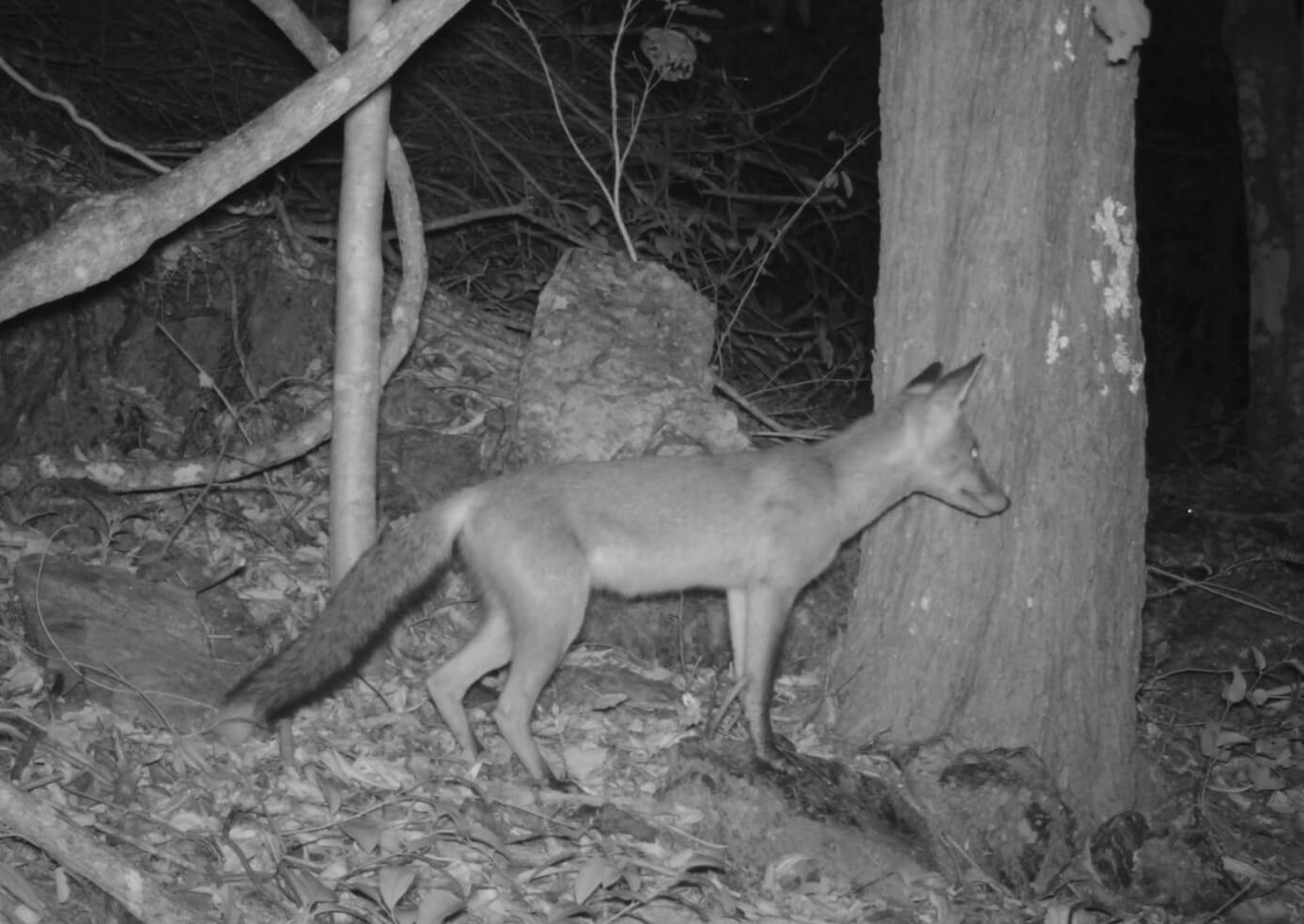Feral animals are a compelling topic for most Australian conservationists. I am always intrigued by the diversity of experiences and opinions out there. It is safe to say that the daily number of native animal fatalities caused by the jaws and claws of pest predators in Australia is in the millions. Yes, that’s daily, and can make one feel quite overwhelmed.
Few feral animal studies have been conducted in SEQ; however, this has recently changed with a four-year research project along the coastal fringe of the Sunshine Coast (between Shelly Beach and Point Cartwright) that focussed on the diet of foxes. Foxes are well known to be opportunistic, smart and resilient. I have heard LfW members at Bellthorpe talk about their local foxes sustaining themselves for months of the year on fallen avocados from orchards. LfW members at Austinville (see facing page case study) have caught images of their local foxes eating bandicoots and possums, night after night. I know my local foxes visit neighbourhood chook pens and have cached partially eaten carcasses in the undergrowth of my yard.

Foxes have played a major role in the extinction of many small to medium sized terrestrial animals in Australia such as rat-kangaroos, bandicoots and native mice. They continue to place pressure on small native mammals, reptiles and ground-dwelling birds like button-quails. Like all good opportunists, foxes adapt their diet to fit their surrounds including rabbits in semi-arid Australia, and in London, probably not surprisingly, about one-third of their diet is left-over human rubbish.
So, what are foxes eating on the Sunshine Coast? It turns out that the main part of their diet is terrestrial arthropods, mainly beetles, and especially Christmas Beetles in summer when the adults emerge from their life in the ground. These coastal foxes are also eating marine arthropods, mostly Ghost Crabs, again primarily during summer. Their next main food source is fruit, including weedy asparagus berries. Foxes took advantage of the Short-tailed Shearwater wreck that occurred in 2013, cleaning up many of the dead, beach-washed birds that did not survive their annual migration.
Sunshine Coast foxes along the coast, are also eating small mammals including the native Grassland Melomys and Swamp Rat, and the introduced House Mouse and Black Rat. However, this is in much smaller quantities and frequency when compared to other Australian studies, where small to medium-sized mammals comprise the bulk of fox prey. Human rubbish, fish and reptiles are only very occasionally eaten.
Foxes, like many birds, are vectors for plant seed dispersal. They eat the fruit of both weeds and native plants, and then deposit the seed at a new location in a nice manure compost.
I am fortunate to work with the researcher who undertook this study, Dr Julie O’Connor, who also manages the LfW team at Sunshine Coast Council. She had the joy of sifting through 1185 fox scats containing 3021 food items to reach these results. Her research also extended into looking at the effectiveness of lethal vs non-lethal control of foxes to protect beach nesting turtle eggs. Interestingly, the non-lethal control (putting exclusion mesh over the turtle nests) looks to be more effective as foxes learn that there is no food available at turtle nests. Whereas lethal control appears to disrupt inter-generational learning within fox family groups and can lead to increased predation of turtle nests.
Like any good science, this research poses more questions and creates space for future studies on feral predators in SEQ. This study shows that foxes, on the coastal strip of the Sunshine Coast, are arguably a low-impact predator and perform some ‘good’ ecological services such as eating carcasses of beach-washed birds, dispersing native seeds and controlling pest rats and mice. This would be a very different story if the turtle eggs were not adequately meshed, or lax rubbish collection enabled foxes to feast on our take-away food scraps, or if there were threatened ground dwelling animals like the Ground Parrot or bilbies.
So for now, as controversial as it may sound, foxes in human-modified coastal ecosystems on the Sunshine Coast are probably performing an important ecological function as the only mammalian predator. It is virtually impossible to imagine quolls, dingoes or Tasmanian Devils, which once filled this ecological niche, returning to this now busy urban region. Thus, in this distinct area, we may wish to change our thinking about foxes from the bad guy to the handy cleaner who can be taught to stay away from turtle nests.
Article by Deborah Metters
Land for Wildlife
Regional Coordinator
References & further reading:
O’Connor JM et.al. (2020) From carrion to Christmas beetles: the broad dietary niche of the red fox in a hybrid coastal ecosystem in south-eastern Queensland. Aust Journal of Zoology.
O’Connor JM et.al. (2019) Is the European red fox a vector of the invasive basket Asparagus (Asparagus aethiopicus) in eastern Australia? Aust Mammalogy.
O’Connor JM et.al. (2017) Anti-predator meshing may provide greater protection for sea turtles nests than predator removal. PLoS ONE 12(2).

Can you help.
I live on the ridges above Lismore, NSW.
At night, I leave out wild bird seed for birds and wallabies.
Red-necked wallabies have long been coming in at night for the seed.
But as far as I’m aware, they have not been leaving large, long and dramatic fecal statements.
Recently, some animal has been leaving huge depositions of black faeces near the seed saucer.
They look a bit like dog poo, or could be huge cat poo. But neither of these eats wild bird seed.
So we have a mystery.
I can send you photos of the scat configurations, mostly long ones rather than short lumps.
Just let me have an address to send them
Hoping you can help.
Hi Earle. You could send photos of the unidentified scats to the Qld Museum Inquiry Centre https://www.museum.qld.gov.au/learn-and-discover/ask-an-expert. It sound like it could be a python scat if it is black and dramatic.